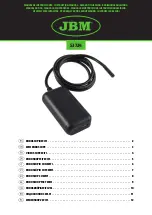
3
3.
Remove the ZONE 1 terminal block from the rear of the speaker selector.
4.
Using a small flathead screwdriver, loosen the two screws in the terminal block.
5.
Insert the stripped ends of one end of one of the speaker wires into the terminal
block, taking care to match the polarity, then tighten the screws. Ensure that there
are no stray wire strands.
6.
Connect the other end of the speaker wire to the first speaker in the 70V speaker
array, taking care to match the polarity.
7.
Insert the terminal block back into the rear of the speaker selector.
8.
Repeat steps 3-7 for the second speaker zone and speaker array.
9.
Remove the INPUT terminal block from the rear of the speaker selector.
10.
Using a small flathead screwdriver, loosen the two screws in the terminal block.
11.
Insert the stripped ends of one end of one of the speaker wires into the terminal
block, taking care to match the polarity, then tighten the screws. Ensure that there
are no stray wire strands.
12.
Connect the other end of the wire to the 70V and Common terminals on your
amplifier, taking care to match the polarity.
13.
Insert the terminal block back into the rear of the speaker selector.
14.
(Optional) Connect a speaker wire to the THRU terminal block on the speaker
selector, then connect the other end to the INPUT terminal block on a second
speaker selector using the same procedure as described above. Repeat as desired.
15.
Turn the two Zone Volume Controls fully clockwise to the full on position. Ensure
that each Zone On/Off Switch is in the on position.
16.
Set the volume control on your amplifier to the minimum position.
17.
Start audio playback, then slowly increase the volume on the amplifier until the
volume is at the highest level you will want with no distortion. If distortion occurs,
reduce the volume level on the amplifier until distortion can no longer be heard.
18.
Reduce the volume controls on the speaker selector to a comfortable listening level.
From here on, leave the volume control on the amplifier alone and use the Zone
Volume Controls on the speaker selector to control the volume levels.






















